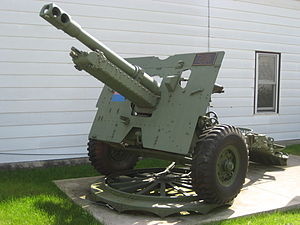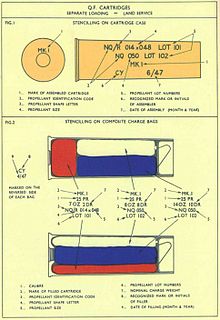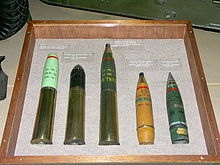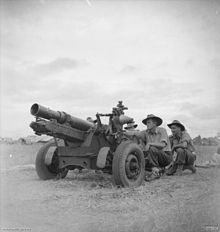- Ordnance QF 25 pounder
-
Ordnance QF 25 pounder
Ordnance QF 25 pounder Gun shown mounted on its firing platform, King Street West, Dundas, Hamilton, Canada.Type Field gun/Howitzer Place of origin  United Kingdom
United KingdomService history In service 1940-present Used by see users Wars World War II
Malayan Emergency
Korean war
Rhodesian Bush War
South African Border War
Dhofar Rebellion
Turkish invasion of Cyprus
Sri Lankan Civil War
Iraq WarProduction history Designed 1930s Manufacturer Royal Ordnance Variants Mk I
Mk II
Mk III
Mk II/I
Mk III/I
Mk IV
Mk I ShortSpecifications (Ordnance QF 25 pounder Mk II on Carriage 25 pounder Mk I) Weight 1,633 kg (3,600 lb) Length 4.6 m (15 ft 1 in) (muzzle to towing eye) Barrel length 2.47 m (8 ft 1 in) Width 2.13 m (7 ft) (width at wheel hubs) Height 1.16 m (3 ft 10 in) (trunnion height) Crew 6 Shell High Explosive
Anti-Tank
SmokeShell weight 11.5 kg (25 lb) (HE including fuze) Calibre 87.6 mm (3.45 in) Breech Vertical sliding block Recoil Hydro-pneumatic Elevation -5° to 45°
(70° with dial sight adapter and digging trail pit or wheel mounds)Traverse 4° Left & Right (top traverse)
360° (platform)Rate of fire Gunfire, 6-8 rpm
Intense, 5 rpm
Rapid, 4 rpm
Normal, 3 rpm
Slow, 2 rpm
Very slow, 1 rpmMuzzle velocity 198 - 532 m/s
(649 - 1,745 ft/s)Maximum range 12,253 m (13,400 yd) (HE shell) Sights Calibrating & reciprocating The Ordnance QF 25 pounder, or more simply, 25-pounder or 25-pdr, was introduced into service just before World War II, during which it served as the major British field gun/howitzer. It was considered by many to be the best field artillery piece of the war, combining high rates of fire with a reasonably lethal shell in a highly mobile piece. It was the British Army's primary artillery field piece well into the 1960s, with smaller numbers serving in training units until the 1980s. Many Commonwealth of Nations countries used theirs in active or reserve service until about the 1970s and ammunition for the weapon is currently being produced by Pakistan Ordnance Factories.
Contents
Design
The design was the result of extended studies looking to replace the 18 pounder (3.3 inch / 84 mm bore) field gun and the 4.5-inch howitzer (114.3 mm bore), which had been the main field artillery equipments during the First World War. The basic idea was to build one weapon with the direct-fire capability of the 18 pounder and the high-angle fire of the howitzer, firing a shell about half way between the two in size, around 3.5 to 4 in (90 to 100 mm) of about 30 pounds (14 kg).
Development during the inter-war period was severely hampered by a lack of money and it was eventually decided to build a "new" design from existing 18 pounders by converting barrels but designing a new barrel and carriage for production when funds were available. The result was a 3.45 in (87.6 mm) weapon firing a 25 pound (11 kg) HE shell. It was mounted on late model 18 pounder carriages. One of these used a firing platform and this was adopted for the new guns. The firing platform was lowered and the gun pulled onto it, providing a flat surface that allowed the gunners to quickly traverse the weapon in any direction.
 A 25-pdr field gun and limber being towed by a Morris Commercial "Quad", crossing a pontoon bridge at Slaght Bridge in Antrim, Northern Ireland, 26 June 1942.
A 25-pdr field gun and limber being towed by a Morris Commercial "Quad", crossing a pontoon bridge at Slaght Bridge in Antrim, Northern Ireland, 26 June 1942.
Unlike the 18 pounder, the 25 pounder used howitzer type variable charge ammunition. For the Mk 1 Ordnance on 18 pounder carriage there were three "charges", Charge 1, 2 and 3 in a single cartridge. The 'proper' 25-pdr, Mk 2 Ordnance on Mk 1 Carriage, also had charge super in a separate cartridge. An increment for charge super was introduced in 1943 to provide higher velocity for anti-tank shot. Subsequently another type of increment was introduced to be added to charges 1 and 2 to provide three additional charge combinations for use with upper register (high angle) fire. The introduction of the increment to charge super was only possible following the addition of the muzzle-brake in the previous year.The 25-pdr was separate loading, the shell was loaded and rammed then the cartridge in its brass case was loaded and the breech closed. In British terminology the 25 pounder was called "Quick Firing" (QF) because the cartridge case provided obturation (it provided the gas seal in the breech) and was automatically released when the breech was opened.
In common with all British guns of the period the indirect fire sight was 'calibrating'. This meant that the range, not elevation angle was set on the sight. The sight compensated for the difference in the gun's muzzle velocities from standard. The gun was also fitted with a direct fire telescope for use with armour piercing shot. It also used 'one-man laying' in accordance with normal British practice.
An important part of the gun was the ammunition limber ("Trailer, Artillery, No 27"). The gun was hitched to it and the trailer hitched to the tractor when on tow. The gun did not need a limber[1] and could be hooked directly to a tractor. The trailer provided the brakes as only a hand brake was fitted to the gun carriage The trailer carried ammunition; thirty-two rounds in trays (two rounds per tray) in the trailer protected by two doors. Ammunition was also carried in the gun tractor with the detachment and various gun stores. Some stores, such as sights, were carried cased on the gun. Each section (two guns) had a third tractor that carried ammunition and towed two ammunition trailers.
The gun detachment comprised the following: No 1 - detachment commander (a sergeant), No 2 - operated the breech and rammed the shell, No 3 - layer, No 4 - loader, No 5 - ammunition, No 6 - ammunition, normally the 'coverer' - second in command and responsible for ammunition preparation and operating the fuze indicator.
The official 'reduced detachment' was 4 men.
Many different Companies manufactured the guns and component parts in the UK. Vickers Armstrong in Scotswood, Baker Perkins in Peterborough and Weirs in Glasgow were some of the most significant. The various Royal Ordnance factories produced most of the ordnance items. In Canada Sorel Industries built complete guns and provided the ordnance for fitting to the Sexton. Australia also built complete guns, chosing to weld the carriages rather than rivet, as was the practice in the UK and Canada. In all over 13000 were made World Wide.
Ammunition
The 25 pounder fired separate ammunition; the projectile and the propelling charge in its usually brass cartridge case with its integral primer were loaded separately. Being a QF gun the cartridge case provided obturation.
There were two types of cartridge. The 'Normal' contained three cloth charge bags (coloured red, white and blue). White and/or blue bags would be removed from the cartridge to give "Charge 1" or "Charge 2", leaving all three bags in the cartridge case gave "Charge 3". The cartridge case was closed at the top with a leatherboard cup. The second type of cartridge was "Super"; it provided charge "Super" only. The cup could not be removed from the cartridge case. In 1943 an Incremental Charge of 5.5 oz of cordite (Super plus) was introduced to raise the muzzle velocity when firing AP shot with charge Super; this required that a muzzlebrake was fitted.[2] Adoption of "upper register" (high angle) fire needed more charges to improve the range overlap. This led to the development of the "Intermediate Increment" of 4oz cordite, which was introduced in 1944. The bags were striped red and white to indicate that they should only be used with Charges 1 and 2. When one bag was used with Charge 1 it provided Charge 1 1/2. When one was added to Charge 2 it provided Charge 2 1/3, and two bags, Charge 2 2/3. This give a total of 7 charges instead of 4.[3]
There were many marks of cartridge mostly differentiated by propellant type. Double base propellant (nitrocellulose/nitroglycerine) was the UK standard but one mark used US single base (nitrocellulose only). However, triple base nitrocellulose/nitroglycerine/picrite was used throughout the war and eventually replaced all others.[4]
The 25 pounder's main ammunition was the High Explosive (HE) streamlined shell with a 5/10 CRH ogive and boat tail. It was also provided with base ejection smoke (white and coloured), star shells, and chemical shells. Incendiary and coloured flare shells were developed but not introduced into service, and smoke shells were sometimes reloaded with propaganda leaflets or metal foil "window". The UK did not develop a WP smoke shell for the 25 pounder.
For anti-tank use, the 25 pdr was also supplied with a limited amount of 20 pound (9 kg) solid armour-piercing (AP) shot, later replaced with a more potent version with a ballistic cap (APBC). The AP shot was fired with maximum charge, Charge No. 3, Super, or Super with Super Increment depending on the ordnance mark, as muzzle velocity was critical in direct fire for penetration and a flat trajectory.
A shaped charge anti-tank shell was under development in Canada, but the introduction of the QF 17 Pounder, an anti-tank gun, in 1944 ended its development. After the Second World War, the UK replaced AP shot with a HESH shell. Coloured marked shells (dye and PETN) were also developed but not introduced.
The standard fuze is No 117 Direct Action (DA). No 119 (DA and graze) was also used. Combustion or mechanical time fuzes were used with base ejection shells and mechanical time with graze were used with HE. VT fuzes were used from the end of 1944 and subsequently replaced by CVT fuzes.
British Service
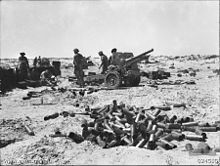 An Australian 25 Pounder at El Alamein in July 1942
An Australian 25 Pounder at El Alamein in July 1942
The 25 pounder was the main field artillery weapon used by British Commonwealth and colonial infantry and armoured divisions of all types during the Second World War. Throughout the war each British-pattern infantry division was established with seventy-two 25 pounders, in three field artillery regiments. Armoured divisions eventually were standardised with two field artillery regiments, one of which was self-propelled (see below). Before mid-1940 each regiment had two batteries of twelve guns; after that date, each regiment had three batteries of eight guns each. In the late 1950s, the British Army reverted to batteries of six guns. Field artillery regiments had two batteries of 25 pounders and one of 5.5 inch guns.
The early 18/25 pdrs had been towed in the field by the Light Dragon, a tracked vehicle derived from a light tank, and the Morris CDSW. Throughout most of the Second World War the 25 pounder was normally towed, with its limber, behind a 4x4 Field Artillery Tractor called a "Quad". These were manufactured by Morris, Guy and Karrier in England, and, in greater numbers, by Ford and Chevrolet in Canada. In the 1950s, the British Army replaced the various "Quads" with a new Bedford 3-ton gun tower fitted with a special to purpose body.
In 1941, the British Army improvised a self-propelled 25 pounder named the Bishop, on the chassis of the Valentine tank. This mount was unsatisfactory, and was replaced in 1942 by the American M7 Priest. However, this complicated the supply of ammunition in the field, and was replaced in 1944 by the Sexton, which was designed and manufactured in Canada and mounted the 25 pounder on a Ram tank chassis.
By World War II standards, the 25 pounder had a smaller calibre and lower shell weight than many other field artillery weapons, although it had longer range than most. (Most forces had entered the war with even smaller 75 mm designs but had quickly moved to 105 mm and larger weapons.) It was designed for the British practice of suppressive (neutralising) fire, not destructive fire that had proved illusory in the early years of World War I. Nevertheless the 25 pounder was considered by all to be one of the best artillery pieces in use. The devastation caused by the gun (and the speed at which the British artillery control system could respond) in the North-West Europe Campaign of 1944–1945 made many German soldiers believe that the British had secretly deployed an automatic 25 pounder.
NATO standardization led to the replacement of the gun with the OTO Melara Mod 56 105 mm howitzer. The last British military unit to fire the 25 pounder in its field role (as opposed to in a ceremonial role) was the Gun Troop of the Honourable Artillery Company on Salisbury Plain in 1992.
A 25 pounder firing a blank
Service With Other Nations
In addition to Commonwealth and colonial forces other Second World War users included the free forces of France, Greece, Poland, Czechoslovakia, Netherlands, Belgium and Luxembourg. The first shot fired by US artillery against the German army in World War II was fired by a 25pdr of the 34th Infantry division.[5]
After the Second World War 25 pounder remained in service with many Commonwealth armies into the 1960s. It was used in Korea by British, Canadian and New Zealand regiments and in Malaya by British and Australian batteries. It also featured in wars on the Indian sub-continent and in the service of Israeli and other Middle Eastern armies.
Since leaving UK service, the last users of the 25-pounder in combat have been the Special Air Service advisors to the Omani Army during the 1972 Battle of Mirbat in Oman, the Cypriot National Guard during the 1974 Turkish invasion of Cyprus and by Kurdish militias in northern Iraq in 2003.
South African Service
The gun was called G1 by the South African Defence Force. It was extensively used in the early stages of the South African Border War, including Operation Savannah. The G1 is still used in the ceremonial role.
Rhodesian Service
The Rhodesian Army used the weapon during the Bush War but by this stage the round could not penetrate enemy bunkers.
Sri Lankan Service
The 25-pounder was extensively used by the Sri Lankan Army during the early years of the Sri Lankan civil war. It still remains in service, although only in a ceremonial role.
Irish Service
In 1949, 48 ex-British Army Mark III 25-pounders were acquired by the Irish Defence Forces and were in service with the Reserve's until 2009, having been replaced in the Army by the 105 mm Light Gun in 1981. The Irish Army continues to maintain a 6 gun ceremonial 25 pounder battery for use in state occasions.
Luxembourg Service
The Luxembourg Army maintains a number of 25 pounder guns rebarreled to 105 mm and fitted with new sights for gun salutes.
Greek service
The 25-pdr first entered service with Greek forces in North Africa during WWII. Three (I,II & III) field artillery regiments were created in total as part of the Greek infantry brigades created. They saw significant action at El Alamein and Rimini. After the war the 25-pdr served as part of the Greek Army during the Greek Civil War. A total of 125 25-pdr guns were used by the Greek artillery during the Civil War of 1946-1949, in various organizational schemes. After the Civil War they were organized into seven independent 18-tube regiments. Following Greece's entry into NATO in 1952 and the standarization in American calibres in 1953, the 25-pdr weren't retired (unlike other models), but were reorganised as 13 8-tube battalions in divisional service. In 1957 the influx of American artilelry pieces permitted an increase from 8 to 12 pieces per battalion. In 1964 a total of 54 25-pdr guns were delivered from Greece to Cyprus, where they entered service with the Cyprus National Guard organized into 4 12-tube battalions (181, 182, 183 and 185) and one independent battery of 6 tubes (184). They saw action during the Turkish invasion of the island in 1974. The 25-pdr remained in Greek Army service until 1992, when they were retired as part of the CFE agreement. The pieces of the Cyprus National Guard remain in storage.
Variants
Mark I
Known officially as the Ordnance, Quick Firing 25 pounder Mark I on Carriage 18-pr Mark IV, or Ordnance, Quick Firing 25 pounder Mark I on Carriage 18-pr Mark V and commonly called the 18/25 pounder. The Mark I was a 25-pr barrel and breech in the modified jacket of an 18 pounder gun, as a 'loose liner'. The jacket provided the interface to the 18 pounder carriage. The earliest versions retained 18 pounder type elevation sights but later ones had Probert pattern calibrating sights on the right side of the saddle. The Mark IV P, carriage was a box trail, Mark V P, was a split trail. These conversions of the 18 pdr first entered British service in 1937. A few were lost in the Norwegian campaign and 704 in France, leaving about the same number in UK's global stocks. They served in North Africa (until about late 1941) and India. This mark of 25 pounder was limited to charge 3 due to its 18 pounder carriage.
Mark II
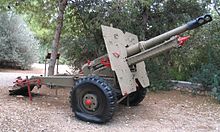 25-pounder with a muzzle brake.
25-pounder with a muzzle brake.
The Mark II, fitted to the Mark I carriage was the standard gun during World War II. They were built in Australia and Canada but mostly in UK. Deliveries (from UK production) started at the beginning of 1940 and first entered service with a Canadian regiment stationed in UK during May 1940. No Ordnance 25-pr Mk 2 on Carriage 25-pr Mark 1 were lost in France. This gun fired all charges, 1 - 3 and Super. In 1942 it was decided to fit a muzzle brake to the gun. This was to eliminate the instability caused when firing the 20lb AP shell with Charge Super. To preserve the gun's balance on the trunnions a counter balance weight was also fitted, just in front of the breech ring. These modifictions did not lead to a change in the gun's nomenclature. Eventually all guns serving in Europe were so converted.
Mark II/I
In 1946 a programme was introduced to modify the gun's breech ring by morticing the rear corners. A corresponding modification was made to the rear corners of the breech block. This was to reduce the instances of cracking the ring.
Mark III
The Mark III ordnance was a Mark II with a modified receiver to prevent the rounds from slipping back out when loading at high angles. Introduced in Jan 1944.
Mark III/I
This was a Mk III gun with the same modification to the ring and block as for the Mk II/I above'.
Mark IV
The Mark IV was identical to the Mark III/I, and featured the modified ring and a paired block from new.
Short, Mark I
Main article: Ordnance QF 25-pounder ShortThe 25 pounder Short Mark I, or Baby 25 pr, was an Australian pack gun version of the 25 pounder, first produced in 1943. This was a shortened version of the standard 25 pounder, mounted on the Carriage 25 pr Light, Mark 1. The Baby was intended for jungle warfare and was only used by Australian units in the South West Pacific theatre of World War II. The gun could be towed by a jeep or broken down into 13 sections and transported by air. During the New Guinea campaign the gun was manhandled up steep jungle tracks where trucks could not operate.
Carriages
Mark I
The Mark I carriage was the first real 25 pounder carriage. Later in World War II some guns had a double shield, two shields separated by spacers, to improve protection. It had a Probert pattern calibrating sights, but with the range indicator wrapped into the distinctive cone that rotated against a fixed reader arm
Jury Axle
In Burma a local modification produced a narrower wheelbase (by about 20-inches) called the Jury Axle. This was suitable for towing by Jeep and could be loaded into a Dakota aircraft. It was subsequently adopted officially with other minor modifications and a new platform for the narrow wheelbase as the Carriage 25 pdr Mark 2. The Mark 3 Carriage, also narrow, included a hinge to make it easier to fire the gun in the upper register (high angle). High angle fire had been introduced in Italy and used the increments originally introduced for anti-tank fire, adding them to charges 2 and 3 to give 25 pounder 7 charges.
Mark II
The Mark II carriage was basically formalisation of the Jury Axle and shield with additional modifications and new narrower track No 22 platform. It was about 20 inches narrower than the standard Mark I carriage.
Mark III
The Mark III carriage was a further development of the Mark II carriage to provide joints that enabled the trail to be cranked for "upper register fire". It entered service at the end of World War II.
Mark IV
The British did further work on the 25 pounder Short, enabling it to fire charge Super. One or 2 prototypes were produced and the carriage was officially designated the Mark IV, but never went into production.
Self-propelled 25 pounders
Bishop
The Bishop was a British self-propelled 25-pounder utilising the Valentine tank chassis.
Sexton
The Sexton was a Canadian self-propelled 25-pounder utilising the Ram or Grizzly tank chassis.
Yeramba
The Yeramba was an Australian self-propelled 25-pounder utilising the M3 Lee tank chassis.
Users
 Australia
Australia Canada
Canada Cyprus
Cyprus Greece
Greece Ireland
Ireland Kingdom of Italy (Captured examples)
Kingdom of Italy (Captured examples) Lebanon
Lebanon Luxembourg
Luxembourg Nazi Germany (Captured examples)
Nazi Germany (Captured examples) New Zealand
New Zealand Oman
Oman Poland
Poland Portugal
Portugal Rhodesia
Rhodesia Singapore (Ceremonial Role only)
Singapore (Ceremonial Role only) South Africa
South Africa Sri Lanka
Sri Lanka United Kingdom
United Kingdom
See also
Notes
- ^ Limbers were necessary for horse-drawn artillery
- ^ Range Table Part 1, Ordnance QF 25-pr Mk 1 and 3, AP 2CRH, Charges 3, Super and Super plus Increment, 1943
- ^ Range Table Part 1, Ordnance QF 25-pr Mk 1 and 3, Standard Projectile, Intermediate Charges, 1944
- ^ Range Table Part 1, Ordnance QF 25-pr Mk 1 and 3, Lower Register, Standard Projectile, 1948
- ^ http://books.google.com/books?id=qRfpxDlDrxgC&pg=PA36&lpg=PA36&dq=25+pounder+in+us+service&source=bl&ots=J63hucl6Jw&sig=nfuyqWJl_Q4TYwgaD1DfcK13tC4&hl=en&ei=ekmRSqeWFJqhjAe2q9iDDg&sa=X&oi=book_result&ct=result&resnum=7#v=onepage&q=&f=false
References
- Various QF 25-pr Range Tables Part 1 1939 - 1967
- Various QF 25-pr UK Gun Drill pamphlets 1939 - 1976
- Various QF 25-pr Handbooks 1940 - 1957
- British and American Artillery of WW2. Ian Hogg. ISBN 0 85368 242 9
External links
- LemaireSoft
- Armor penetration table
- Pakistan Ordnance Factories - current producer of 25 pounder ammunition
- Ordnance Q.F. 25-pr Mk 2 on Carriage 25-pr Mk 1
British and Commonwealth artillery of World War IITank & anti-tank guns QF 2 pounder · QF 6 pounder · OQF 75 mm (tank only) · QF 17 pounder · 77 mm HV (tank only) · QF 3 inch Howitzer · QF 95 mm Howitzer (tank only)Field guns and howitzers Medium and Heavy guns and howitzers BL 60 pounder gun · 4.5 inch Medium Field Gun · 5.5 inch Medium Gun · 6 inch Howitzer · 7.2 inch Howitzer · 8 inch Howitzer · BL 9.2 inch HowitzerMountain guns Anti-aircraft guns QF 2 pounder naval gun · 20 mm Oerlikon · 20 mm Polsten · 40 mm Bofors · QF 3 inch · QF 3.7 inch · QF 4.5 inch Mk II · QF 5.25 inch Mk IICoast defence Railway artillery Weapons of the British Empire and the Commonwealth of Nations 1722–1965Handguns Rifles and carbines Brown Bess Musket · Ferguson rifle · Nock gun · Baker Infantry Rifle · Brunswick rifle · Enfield 1853 Rifled Musket · Snider-Enfield · Martini-Henry · Martini-Enfield · Lee-Metford · Lee-Enfield · Ross rifle · Lee-Enfield No.5 Mk.I "Jungle Carbine" · Howell Automatic Rifle · Huot Automatic Rifle · Reider Automatic Rifle · De Lisle Commando Carbine · L1A1 SLRSubmachine guns Rapid-fire weapons Bira gun · Nordenfelt gun · Gatling gun · Gardner gun · Maxim gun · QF 2 pdr "Pom-Pom" · Vickers Gun · Lewis Gun · Vickers-Berthier · Vickers K machine gun · Charlton Automatic Rifle · Besa · Besal · Bren gunAnti-tank weapons Field guns
and other weapons25 pdr Field Gun · Congreve rocket · SBML 2-inch Mortar · Ordnance ML 3 inch Mortar · No.2 "Lifebuoy" Flamethrower · Stokes Mortar · OTO Melara Mod 56Categories:- 88 mm artillery
- World War II field artillery
- Cold War field artillery
- World War II artillery of the United Kingdom
- Cold War artillery of the United Kingdom
Wikimedia Foundation. 2010.

